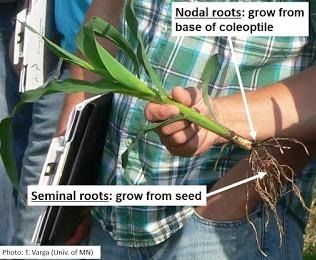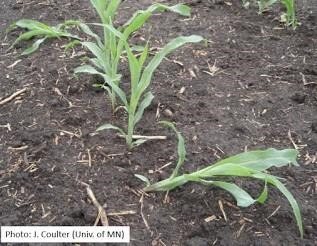By Jeff Coulter
With corn emergence complete and rapid vegetative growth about to begin, now is the time to think about early season corn growth and development, the factors affecting it, and how this influences yield.
Corn growth and growing degree days (GDDs)
From emergence until the V10 (10 leaf collar) stage, a new leaf collar becomes visible on corn with every 82 GDDs (Nielsen, 2019). From the V10 stage until the last leaf (just before tasseling), a new leaf collar becomes visible with every 50 GDDs. Thus, rapid corn growth and nutrient uptake begins around the V10 stage.
Daily GDDs are calculated based on daily high and low air temperatures, measured in degrees Fahrenheit, as:
GDDs = [(High + Low)/2] - 50°F
where High is the daily high (set to 86°F if the daily high exceeds 86°F) and Low is the daily low (set to 50°F if the daily low is less than 50°F). Hence, 20 GDDs are accumulated on a day with a maximum air temperature of 80°F and a minimum air temperature of 60°F. Under these temperature conditions in early June, corn would advance by one leaf stage about every four days.
Growing point location
The growing point of corn remains below ground until the five leaf collar (V5) stage, and is about one inch above the soil at the six leaf collar (V6) stage. After this, the growing point advances rapidly up the stalk as it elongates. A corn plant will not recover if it is cut off below the growing point, but it will continue to grow if it is cut above the growing point.
Successful nodal root establishment is critical

Corn has two types of roots: (1) temporary roots that grow from the seed (referred to as seminal roots), and (2) primary roots (also known as nodal roots) that grow from the base of the coleoptile, located about 0.75 inches below the soil surface.
The soil depth at which nodal root growth begins is unaffected by planting depth, unless corn seed placement is accidentally 0.75 inches or less, resulting in nodal root growth occurring from shallower than 0.75 inches.
At the V3 (three leaf collar) stage, corn plants transition from dependence on seminal roots and kernel reserves to the nodal roots. The nodal roots are the major supplier of water and nutrients from the V6 stage to maturity. Therefore, successful nodal root establishment is critical for a high-yielding corn crop.
 |
Corn plants that fell over due to a poor
nodal root system. |
Since nodal root growth begins at just 0.75 inches below the soil surface, it is greatly influenced by near-surface soil conditions. Dry soil at a depth of 0.75 inches can restrict nodal root growth, especially when it is compacted or cloddy.
Surface soils that remain excessively dry after planting and are cloddy, loose, or compacted can be difficult for nodal roots to establish in. When this happens, a corn plant can fall over beginning at around the V5 stage, as the small nodal root system is unable to support the weight of the plant.
Plants that fall over are unlikely to contribute to grain yield unless they can survive with their limited root system until there is adequate rainfall to enable growth of additional nodal roots in moist soil.
Carryover of certain herbicides from the previous growing season, due to factors such as insufficient rainfall or time since application of the herbicide, can also restrict nodal root development, but typically to a lesser degree than described above.
Ear size determination
The number of rows of kernels per ear is established between the V5 and eight leaf collar (V8) stages and is mainly influenced by genetics, while the number of potential kernels (ovules) per row is finalized by the 12 to 15 leaf collar (V12 to V15, respectively) stages and is largely affected by growing conditions (Nielsen, 2007). Therefore, stress to corn between the V5 and V15 stages can reduce the number of ovules per ear, mainly through a reduction in the number of ovules per row. However, the number of ovules that develop into kernels is determined by the success of pollination and the ability of those kernels to be retained (not dry out) after pollination.
Source : umn.edu